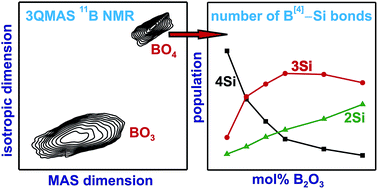Structure–composition relationships of bioactive borophosphosilicate glasses probed by multinuclear 11B, 29Si, and 31P solid state NMR
Abstract
By combining 11B, 29Si, and 31P nuclear magnetic resonance (NMR) experimental results, we present a comprehensive structural investigation of 15 borophosphosilicate (BPS) glasses of the Na2O–CaO–B2O3–SiO2–P2O5 system: in two base compositions comprising 46 mol% (“S46”) and 49 mol% (“S49”) SiO2, progressive replacements of SiO2 by B2O3 were performed at a constant total Na2O and CaO content. The S46 glass members constitute B-bearing analogs of “45S5 Bioglass” that is utilized extensively for bone grafting in periodontal and orthopedic surgery. Orthophosphate ions prevail throughout all structures, while the silicate network polymerization increases slightly with a growing amount of B2O3 in the glass. 11B NMR revealed continuous BO3 → BO4 conversions for increasing B2O3 content, with asymptotic fractions of 34% and 43% of B[4] coordinations out of the borate speciation observed for the series of S46 and S49 glasses, respectively. While all BPS glasses are homogeneous across a μm-scale, strong preferences for B[3]–O–B[3] and B[4]–O–Si[4] bond formation lead to structures comprising (sub)nm-sized domains of BO3 groups in boroxol rings and borosilicate networks built by SiO4 and BO4 tetrahedra. These borate/borosilicate networks are merged mainly by B[4](3Si) and B[3](1Si) moieties in Si-rich BPS glasses (where each value in parentheses specifies the number of bonds to Si atoms), while B[4](3Si) and B[4](2Si) groups are the dominant network contact points in the B-rich glasses. We discuss the partitioning of non-bridging oxygen ions between the BO3 and SiO4 groups, the relative propensities for B[4]–O–Si[4] and B[4]–O–B[3] bond formation, as well as the expected bearings of our proposed BPS structural model for the glass degradation in aqueous media, where we identify the fractional population of B[4] coordinations and the silicate network connectivity to constitute the dissolution-controlling parameters.


 Please wait while we load your content...
Please wait while we load your content...